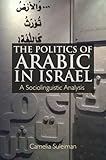The Politics of Arabic in Israel : A Sociolinguistic Analysis / Camelia Suleiman.
Material type: TextPublisher: Edinburgh : Edinburgh University Press, [2022]Copyright date: ©2017Description: 1 online resource (240 p.) : 52 B/W illustrationsContent type:
TextPublisher: Edinburgh : Edinburgh University Press, [2022]Copyright date: ©2017Description: 1 online resource (240 p.) : 52 B/W illustrationsContent type: - 9781474420860
- 9781474420877
- 306.44095694 23
- online - DeGruyter
| Item type | Current library | Call number | URL | Status | Notes | Barcode | |
|---|---|---|---|---|---|---|---|
 eBook
eBook
|
Biblioteca "Angelicum" Pont. Univ. S.Tommaso d'Aquino Nuvola online | online - DeGruyter (Browse shelf(Opens below)) | Online access | Not for loan (Accesso limitato) | Accesso per gli utenti autorizzati / Access for authorized users | (dgr)9781474420877 |
Frontmatter -- Contents -- Figures -- Acknowledgements -- Introduction -- 1 Historic Background -- 2 Orientalisation, Securitisation and Minoritisation of Arabic -- 3 The (in)Visibility of Arabic: The Linguistic Landscape -- 4 Modernisation, Globalisation and Citizenship in Israel -- 5 Autobiography and Language Choice -- 6 Arabic in Jordan and Palestine -- Conclusion -- Bibliography -- Index
restricted access online access with authorization star
http://purl.org/coar/access_right/c_16ec
Explores the contradictory position of Arabic being both the official language and marginalized in IsraelArabic became a minority language overnight in Israel in 1948, as a result of the Palestinian exodus from their land that year. Although it remains an official language, along with Hebrew, Israel has made continued attempts to marginalize Arabic on the one hand and securitize it on the other. Camelia Suleiman delves into these tensions and contradictions, exploring how language policy and language choice both reflect and challenge political identities of Arabs and Israelis. She explores the historic context of Arabic in Israel, the attempts at minoritising, Orientalising and securitising the language, the Linguistic Landscape (LL) of Arabic in Israel, the effect of globalization, modernization and citizenship status on the status of Arabic, Hebrew as a language choice of (semi) autobiographic production of three Israeli authors who are native speakers of Arabic, and lastly, a comparison with the status of Arabic in both Jordan and Palestine (West Bank and Gaza Strip) where Arabic is the official language.Key FeaturesCombines a variety of qualitative methods not commonly used together into the study of Arabic in Israel including ethnography, interviews with journalists and students, media discussion of the language situation of Israel, and analysis of the production of knowledge on Arabic in Israeli academiaProvides a comparative analysis of the language situation in Israel with that in Jordan and PalestineEmploys studies in post-colonial theory, theory of linguistic anthropology, and sociolinguistic concepts of ‘indexicality’ and ‘linguistic landscape’
Mode of access: Internet via World Wide Web.
In English.
Description based on online resource; title from PDF title page (publisher's Web site, viewed 29. Jun 2022)


